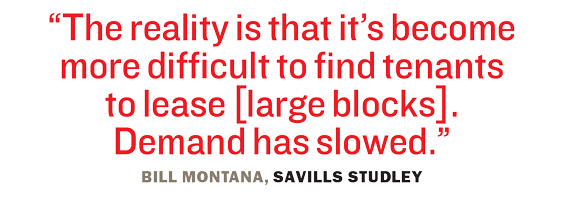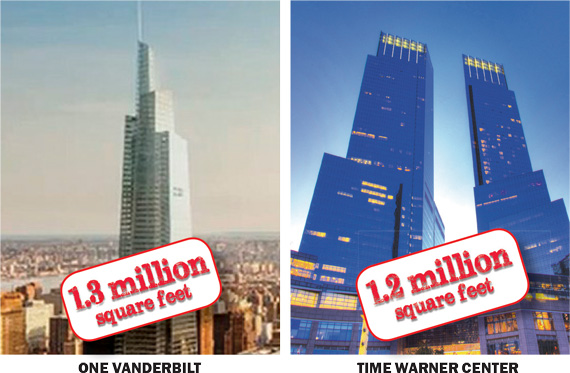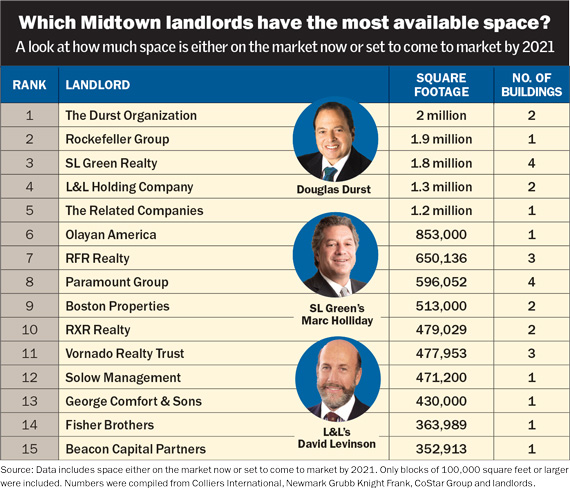By now the headlines are familiar: Tenant X is heading Downtown or Tenant Y is taking space on the Far West Side.
But what’s often left out of the headlines is that those tenants are leaving behind giant blocks of office space elsewhere. And, more often than not, those empty sites are located in Midtown.
While Midtown has been losing its competitive edge for some time, the slippage has accelerated in the last few years as new office supply has come on the market in other parts of Manhattan and the Midtown stock has become dated.
Since 2011, Midtown has seen its roster of tenants vacate 5 million square feet more than they’ve gobbled up. That’s enough space to fill the Chrysler Building twice — with space left over.
And brokerage Newmark Grubb Knight Frank [TRDataCustom] found 86 contiguous blocks of Midtown office space larger than 100,000 square feet either on the market now or set to become available within the next few years. That’s up 72 percent from 2007’s 50 blocks. To be sure, the district’s 10.5 percent availability rate has remained relatively steady, a fact brokers attribute to businesses there growing and expanding their existing footprints. But sources say the numbers don’t capture the shift that’s expected in the next few years. NGKF calculated that roughly 12 million square feet of new construction is set to come online in Manhattan in the next five years, much of it Downtown and on the Far West Side. About 3.8 million of that is already leased up largely from tenants expected to depart from Midtown — which is bound by 65th Street to the north and around 30th Street to the south, from river to river.
This month, The Real Deal looked at which landlords have the most big-block space to lease up in Midtown in the next five years — meaning space that’s either currently available or will be by 2021.
The ranking — which TRD compiled with numbers from CoStar Group, brokerages and landlords — found that the Durst Organization has the most space (2 million square feet) available in Midtown.
The company was followed by the Rockefeller Group (with 1.9 million square feet); SL Green Realty (with 1.8 million); L&L Holding Company (with 1.3 million); and the Related Companies (with 1.2 million).
Those firms, along with the other landlords on TRD’s ranking, will undoubtedly see competition intensify to fill large office blocks.
Leading the migration out of the district are mega tenants like Time Warner (which is leaving its namesake building in Columbus Circle), white-shoe law firm Skadden, Arps, Meagher & Flom (which is packing up at 4 Times Square) and global advertising media firm GroupM (which is decamping from 498 Seventh Avenue.)
 “With an increase in vacant large-block opportunities in Midtown on the horizon, landlords find themselves in a position to differentiate themselves amongst a crowded field,” NGKF research director Jonathan Mazur told TRD.
“With an increase in vacant large-block opportunities in Midtown on the horizon, landlords find themselves in a position to differentiate themselves amongst a crowded field,” NGKF research director Jonathan Mazur told TRD.
Savills Studley broker Bill Montana agreed. “For landlords with large blocks of available space, the reality is that it’s become more difficult to find tenants to lease them,” he said. “Demand has slowed.”
Sweetening the pot
Durst no doubt has its plate full for the next few years. The company has 1.4 million square feet to fill up at 4 Times Square alone.
Publishing giant Condé Nast left in late 2014 for One World Trade Center, which Durst owns with the Port Authority of New York and New Jersey.
But the move was carefully orchestrated by Durst. Not only did the deal get the ball rolling on leasing at the 3-million-square-foot Downtown tower, but the Port Authority agreed to cover the publisher’s monthly Times Square rent until its lease expires in 2019 — or Durst finds a new tenant.
Tom Bow, Durst’s vice president of leasing, said the company has leases out with several large tenants (who he declined to name), and is making capital improvements that include adding about 12,000 square feet of outdoor space on the building’s setbacks.
“Instead of having to go to the top of the Knickerbocker [Hotel] to have drinks, they can have their own terrace,” he said, adding that the landlord is offering tenant-improvement allowances in the range of $70 to $75 per square foot. (By comparison, landlords in Midtown were offering an average of nine months of free rent and $74 a foot in tenant allowances in the second quarter, according to CBRE.)
While the Condé Nast deal may have been good for Durst, Skadden’s planned departure is undoubtedly a blow. The law firm is vacating 600,000 square feet in 2020 and moving into Brookfield Property Partners’ under-construction Manhattan West tower on Ninth Avenue.
Durst will also have about 540,000 square feet to fill at 1155 Avenue of the Americas when law firm White & Case moves up the street to the Rockefeller Group’s 1221 Avenue of the Americas.
Bow said leasing at 1155 kicked off in July. The landlord is repositioning the property as a boutique office building and targeting companies looking for relatively smaller floor plates in the 16,000-square-foot range, he added. Durst is also moving the building’s entrance so that it will face Bryant Park.
Landlords have been wooing tenants with these types of improvements and financial incentives for several years now.
Around 2013, Brookfield started dangling financial carrots in front of tenants to plug a 3-million-square-foot hole left at Brookfield Place in Lower Manhattan when Deloitte and Nomura Bank left and Bank of America shrunk its footprint.
Once Brookfield began cutting deals, other large buildings followed. For Midtown landlords, it became especially necessary to compete with new construction projects.

Midtown buildings with the most space to fill
“At some point then it just becomes market,” said Craig Caggiano, an executive director at Colliers International. “You’ve got a landlord competing to keep a tenant in Midtown as opposed to going to Hudson Yards, [so] they’re compelled to match what Hudson Yards is going to make in terms of the deal.”
A number of landlords in Midtown are spending tens of millions to upgrade their buildings.
Of the top 15 Midtown landlords on TRD’s ranking, six are planning lobby renovations.
Durst and Rockefeller, for example, are spending $90 million and $30 million at 1155 and 1221 Avenue of the Americas, respectively.
NGKF’s Mazur said those types of improvements pay off. He noted that several Midtown buildings that have completed lobby renovations in the past few years have seen “approximately 20 percent higher rents.”
Large and in charge
Rockefeller has just one building with a large block available, but at 1.9 million square feet, it’s the biggest available space in Midtown.
Indeed, at 1271 Avenue of the Americas, the landlord recently lost its anchor tenant, Time Inc., which is relocating to Brookfield Place. But Rockefeller is embarking on a massive upgrade of the 1950s-era building.
Dwayne Doherty, a spokesperson for the firm, said the company is spending $600 million to redevelop the tower, a little more than half of which will be spent on construction, with the remainder set aside for brokerage fees and tenant improvement concessions.
“We’re seeing a lot of activity with a good number of large-block requirements coming through 1271,” Doherty said. “As we sign deals and we ramp up the construction, that … will drive more activity.”
Sources say Rockefeller is also expecting to close a deal with Major League Baseball for roughly 500,000 square feet at the building.
Meanwhile, SL Green, the city’s largest office landlord, has a sizable amount of office space to lease up at several of its Midtown buildings.
But the bulk of the space is at its planned 65-story One Vanderbilt, where it locked in TD Bank for 200,000 square feet, but still has 1.3 million square feet to go.
Steve Durels, SL Green’s leasing director, said on an April earnings call that the company is mostly speaking with “significant sized tenants” in the financial service sector and international companies.
“Our single greatest challenge, quite frankly, is that we’re five years out as far as being able to deliver,” he said. “So, that’s very early in the timeline for tenants to be able to make decisions.”
Elsewhere in its Midtown portfolio, SL Green will have a 162,000-square- foot block available next year when the advertising company Omnicom downsizes at 220 East 42nd Street, plus a pair of roughly 110,000-square-foot blocks at the International Gem Tower on West 46th Street, which the company owns as commercial condos.
One decision all landlords have to make is whether to break up large blocks or keep them as is and search for monster tenants.
Both have pros and cons. The market for smaller tenants is more active, but signing multiple tenants is often more laborious because it involves multiple deals. Going after larger tenants requires patience, but comes with a monetary gain: Blocks of 250,000 square feet or more in Midtown had an average asking price of about $105 per square foot in the second quarter, a 26 percent markup over the submarket’s average.
Durels said that despite the fact that more office blocks are coming to market, there’s still “a premium” in maintaining large spaces.
“If you’re a tenant who goes out looking for a couple of hundred thousand square feet and you need that space . . . your selections are pretty thin,” he said. “I think I would still expect to see a premium [on the] bigger block.”
Meanwhile, L&L’s 1.3 million square feet is concentrated in two buildings (390 Madison Avenue and 425 Park Avenue). Related’s 1.2 million square feet is all housed at the Time Warner Center, where anchor tenant Time Warner is leaving, though it’s trading up to the developer’s massive new project at Hudson Yards.
Further down on the ranking at No. 8, Paramount Group has nearly 600,000 square feet at four Midtown buildings, all within a stone’s throw from each other, that will become available within the next few years.
Ted Koltis, Paramount’s executive vice president of leasing, said during a first-quarter earnings call that the company had not yet decided whether to break the blocks up.
“Tough to say, we’ve got proposals [from tenants] that would take most of the block, and then we’ve got some single-floor users as well,” he said.
Savills Studley’s Montana said so-called “commodity” space — the cookie cutter Midtown space that’s in great supply — will be the toughest to reinvent for the modern workforce.
“It’s not like Midtown South, where big blocks of space are scarce. In Midtown, particularly the Sixth Avenue area, there are numerous big blocks of space,” he said.
“Those buildings are going to have to get aggressive and differentiate themselves to compete for tenants.”
Hurting on the high end
It should be said that Midtown is the city’s largest office submarket — by far. It has 234 million square feet, followed by Downtown with about 86 million and Midtown South with roughly 73 million, according to CBRE.
So when new parts of the city emerge as office districts, it’s not surprising that Midtown would take a big hit.
Interestingly, however, the available space is not just limited to run-of-the-mill corridors.
At least 10 large blocks set to become available are located on Park Avenue, one of the priciest office markets in the city.
Citigroup will leave behind a 393,000-square-foot block at Boston Properties’ 399 Park next year. L&L’s 425 Park Avenue still has 430,000 square feet to lease, and RFR Realty’s Seagram Building at 375 Park will have a block of 236,000 square feet when Wells Fargo leaves in 2021.
Solow Management, No. 12 on the ranking, will have a block of 193,000 square feet available at 9 West 57th Street in 2020 when the private equity firm KKR leaves for Hudson Yards.
But Sheldon Solow, a notoriously selective landlord, cannot be used as a gauge for the market because he meticulously curates his tenants.
“There should always be an asterisk next to that,” Colliers’ Caggiano said. “Solow will do just whatever he wants with that building, and if he wants to keep just a few thousand square feet off the market, then he just won’t lease it.”
Still, JLL vice chairman Rob Martin — who was the firm’s top producer nationally in 2015 — said tenants at the high end of the Manhattan market will see prices softening.
“The biggest value over time will be at the higher end,” said Martin. “Buildings that rent north of $100 per foot, there has always been a limited demand, and there’s a lot more supply coming on. We’re already starting to see concession packages go up.”
“It’s a return to a tenant market,” he added. “It’s a great time to be a tenant.”

